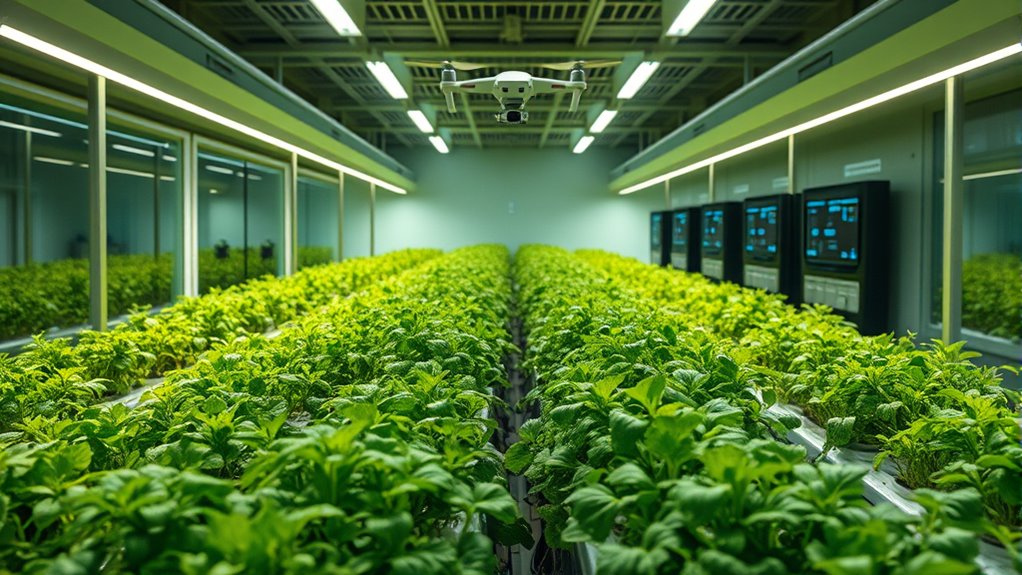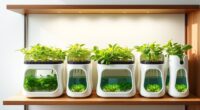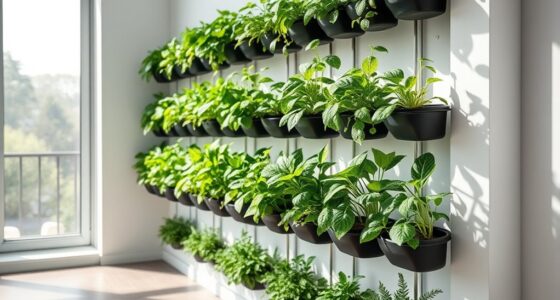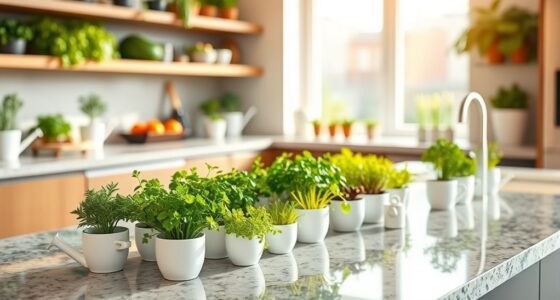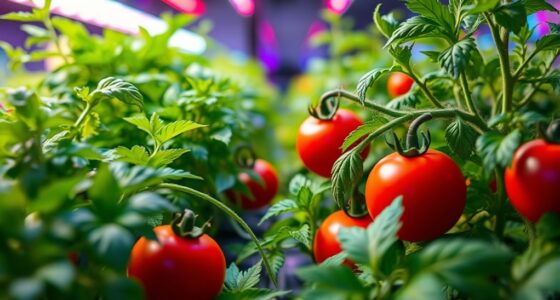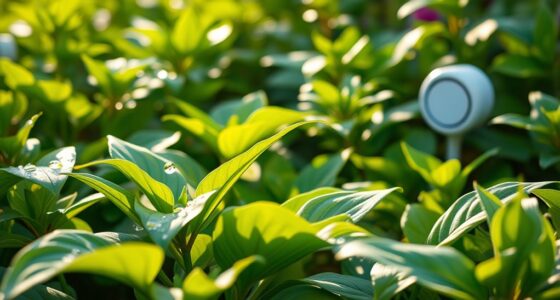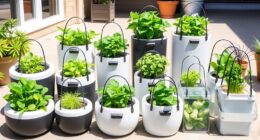Indoor gardens powered by IoT technology are shaping the future of food by making sustainable, year-round farming accessible right at home. These smart systems monitor environmental conditions, optimize water and light use, and help you grow fresh herbs, vegetables, and fruits indoors. They reduce your carbon footprint and reliance on industrial agriculture. If you’re curious about how this innovative approach could transform your food experience and urban living, there’s more to discover ahead.
Key Takeaways
- IoT indoor gardens enable sustainable, year-round food production within urban spaces, reducing reliance on traditional agriculture.
- Smart sensors and automation optimize plant care, conserving resources like water, energy, and reducing chemical use.
- These gardens promote local food access, lowering transportation emissions and supporting environmentally friendly practices.
- They foster personal empowerment by allowing individuals to grow fresh, organic produce at home regardless of external conditions.
- The integration of IoT technology signifies a shift towards resilient, scalable urban farming solutions shaping the future of food.
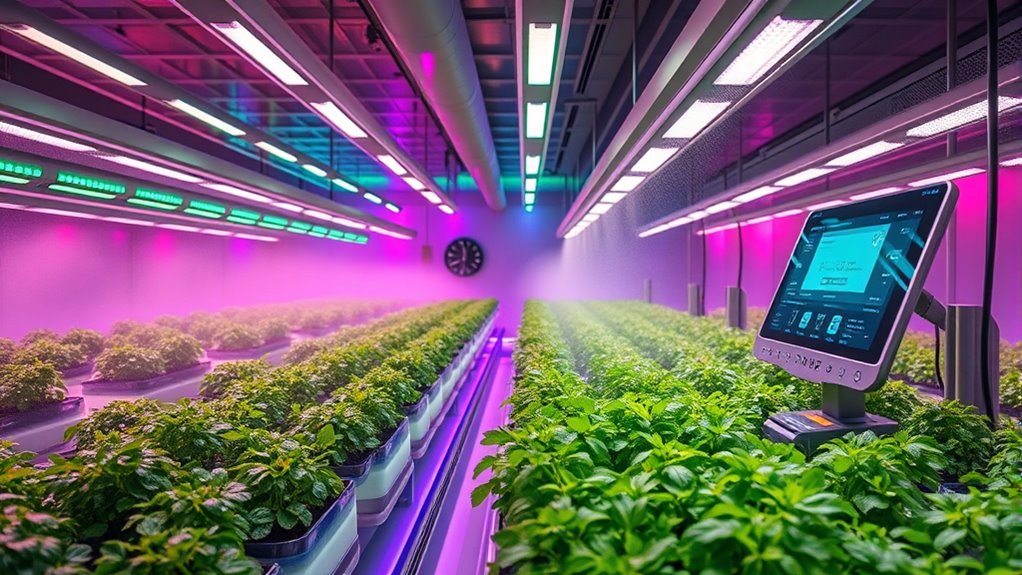
As urban spaces grow more crowded and climate change challenges traditional farming, indoor gardens are emerging as a practical solution for sustainable food production. You might find yourself wondering how to grow fresh vegetables and herbs without leaving the city or relying on long supply chains. Indoor gardens enable you to participate in urban agriculture, bringing farming directly into your living space. This approach supports sustainable farming practices by reducing transportation emissions, conserving water, and minimizing the need for chemical pesticides and fertilizers. With the rise of IoT (Internet of Things) technology, managing your indoor garden becomes easier and more efficient than ever.
Indoor gardens promote sustainable urban farming with IoT technology, reducing emissions, conserving water, and enabling fresh, homegrown produce.
You can harness smart sensors, automated watering systems, and app-controlled lighting to optimize plant growth. These innovations allow you to monitor environmental conditions like humidity, temperature, and light levels remotely, ensuring your plants get exactly what they need without waste. The convenience of IoT devices means less guesswork and more consistent results, making indoor gardening accessible even if you’re new to farming. By integrating technology, you actively participate in urban agriculture in a way that’s sustainable and scalable. You’re not just growing food; you’re contributing to a greener, more resilient food system.
Indoor gardens also help you reduce your carbon footprint, since you’re producing food close to where you consume it. This local approach cuts down on transportation emissions and packaging waste associated with store-bought produce. Plus, many IoT-enabled systems are designed to be energy-efficient, using LED grow lights and optimized watering schedules to use minimal resources. As a result, you’re practicing sustainable farming right in your home, making a tangible impact on environmental conservation. The ability to grow fresh herbs, vegetables, and even small fruits indoors means you can enjoy nutritious, organic produce year-round, regardless of external weather conditions.
Furthermore, indoor gardening fosters a connection to food that many have lost in modern society. It’s empowering to see your plants thrive under your care, especially when supported by smart technology. You’re not only producing food but also gaining valuable knowledge about sustainable farming practices and urban agriculture. This hands-on approach encourages self-sufficiency and reduces dependence on industrial agriculture, which often relies heavily on intensive chemical use and resource depletion. As IoT-powered indoor gardens become more popular, they’re shaping a future where food production is more local, sustainable, and resilient—right in your home. This shift allows you to take part in a movement that’s redefining how we grow, share, and consume food in our ever-changing cities. Additionally, integrating emerging technologies like IoT can accelerate the adoption of innovative solutions in urban farming, making it more accessible and efficient for everyone.
Frequently Asked Questions
How Secure Are Iot Indoor Garden Systems From Cyber Threats?
You might wonder how secure IoT indoor garden systems are from cyber threats. While many devices use data encryption to protect your information, cyber vulnerabilities still exist, especially if you don’t update firmware regularly or use weak passwords. To stay safe, you should keep your system’s software current, enable strong security features, and monitor for unusual activity. These steps help minimize risks and keep your indoor garden secure against cyber threats.
What Are the Initial Costs of Setting up an Iot Indoor Garden?
Think of setting up an IoT indoor garden as planting the seeds for your green sanctuary. Your initial investment covers setup expenses like smart sensors, automated watering systems, and a stable Wi-Fi connection. Costs can range from a few hundred to over a thousand dollars, depending on the size and sophistication. While it might seem like a hefty outlay, you’re investing in a future of fresh, homegrown produce with tech at your fingertips.
Can Iot Indoor Gardens Be Customized for Specific Dietary Needs?
With IoT indoor gardens, you can easily customize your plants for personalized nutrition and dietary needs. You select specific seeds and adjust nutrient levels, ensuring your garden grows foods tailored to your dietary preferences. The smart technology monitors and fine-tunes conditions, enabling precise dietary customization. This way, you get fresh, nutrient-rich produce designed for your health goals, making IoT indoor gardens a flexible solution for meeting your unique nutritional requirements.
How Do Iot Gardens Impact Traditional Farming Industries?
You see, IoT indoor gardens are transforming traditional farming industries by promoting urban agriculture and sustainable farming practices. As you adopt these smart systems, you reduce reliance on large-scale farms, decrease resource consumption, and increase local food production. This shift encourages a more eco-friendly approach, helping you support community-based agriculture while reducing environmental impacts. Overall, IoT gardens complement traditional methods and pave the way for a more sustainable and resilient food system.
What Maintenance Is Required for Long-Term Iot Indoor Garden Operation?
For long-term IoT indoor garden operation, you’ll need to regularly check automation systems and address challenges that arise. You should monitor plant health continuously using sensors, adjusting water, light, and nutrients as needed. Keep software updates current to prevent automation challenges, and clean sensors to guarantee accurate readings. Consistent maintenance of equipment and data analysis helps maintain ideal plant health, ensuring your garden thrives over time with minimal manual intervention.
Conclusion
As you consider the rise of IoT indoor gardens, it’s clear they’re transforming how we grow and consume food. With technology making gardening easier and more efficient, it’s like bringing nature right into your home. Do you want to be part of this sustainable, high-tech food revolution? Embracing these innovations could mean fresher meals and a greener planet—so why not take the leap and see what indoor gardening can do for you?
